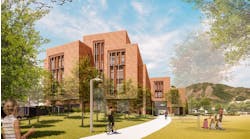-
CHPS (Collaborative for High Performance Schools) is a national non-profit organization that offers resources, assessment tools and recognition programs for building and operating high-performance, healthful, green schools. It offers state-specific rating systems designed by school facilities experts to create schools that are both good on the environment and healthful for users. Schools can receive third-party verification, and they also can self-verify. (www.chps.net/)
-
Commissioning is a process to determine if building goals get met. Performance goals are set and communicated to the members of the design and construction team. The building is tested after construction to see if it indeed met performance goals, and adjustments are made if not.
-
Green buildings are sited, designed, constructed and run in a manner that promotes resource conservation and care for the environment.
-
High-performance schools enhance learning, reduce energy consumption and improve health and comfort through qualities such as good indoor air, lighting and noise reduction. (www.epa.gov/iaq/schooldesign/highperformance.html)
-
LEED (Leadership in Energy and Environmental Design) is a green building certification system created by the USGBC. LEED certification is recognized nationally and uses points to achieve certification levels from the minimum, a LEED-certified building, followed by silver, gold and, for the highest points, a LEED platinum rating. There is a LEED rating system specific to schools.
-
A LEED AP (LEED Accredited Professional) has demonstrated a thorough understanding of green building practices and principles. An AP is credentialed to oversee the LEED certification process.
-
Life-cycle costing takes into consideration the long-term costs and benefits of operations and maintenance when comparing different designs to reveal the "best over time" investment choice.
-
USGBC (The U.S. Green Building Council) is a non-profit organization committed to expanding sustainable building practices. Its mission is to transform the way buildings and communities are designed, built and operated. (www.BuildGreenSchools.com)
-
A Whole system or whole building approach focuses on how the parts work together, not on separate components of a building. Green systems are considered at the start of the development process, rather than a later addition, and care is taken in how they work together to increase their impact.
Sponsored Recommendations
Sponsored Recommendations
Latest from Green
Latest from Green
CU Boulder will build $175.4 million academic facility
April 12, 2024
Sustainable steps
April 8, 2024

